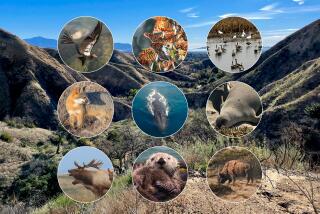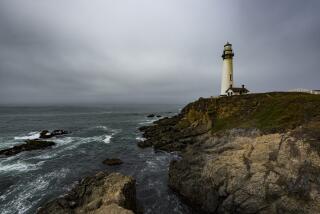ALASKA / PACIFIC NORTHWEST : Alaska’s WILD KINGDOM : BIRDS: COUNTING THE MILLIONS FROM A LODGE ON THE COPPER RIVER DELTA
- Share via
CORDOVA, Alaska — Out here on the mud flats of Goose Cove, about 160 miles southeast of Anchorage, physics plays games with my eyes. Refracted light makes a barrier island hover in midair and makes gulls look like giants with bony legs and beer bellies.
The mirages are amusing but unnerving. I start scanning east with my binoculars, but stop abruptly to zero in on the image of a large, cresting wave. A tsunami? I lower the binoculars and squint out toward the sea. A calm, shimmering horizon winks back. But I know there is something out there.
It’s a long way to high ground. I’d have to sprint across the mud flats and through a meadow to get to the moss-draped Sitka spruce trees where naturalists Pete and Belle Mickelson have their birding lodge along the Copper River Delta eight miles south of the fishing town of Cordova.
Belle once told me that if a tidal wave ever came, she would grab the kid, the computer and her fiddle, and dash to the ridge above the house. She’d heard how a man vanished near here in the 1964 Good Friday Earthquake. After climbing a bluff to safety, he had gone back for his rifle when a great quake-induced wave hit.
I know better than to believe what my eyes are telling me, but my heart’s beating like crazy. I raise the binoculars again. The tsunami is jogging in place.
Then it occurs to me: This is spring. What I’m seeing is a tidal wave of birds.
It’s impossible to tell what kind or how many. The mirage is distorting the motion of their wings, bouncing movement off the water’s glare, churning the image into froth. I assume there are more birds than I could begin to count.
This is my favorite place to be in the spring, when the sky becomes a river of migrating birds and the delta an eddy in the current. Even though there’s a good chance it will rain the entire time I’m here, there’s nowhere I’d rather be. The tropics can wait until after migration.
I’m not as reliable as the birds, but I’ve come for three spring migrations in the past 10 years. The birds arrive on the Copper River Delta beginning in early April. Millions of them. Canada geese, western sandpipers, green-winged teals, horned grebes, American widgeons, sandhill cranes, Barrow’s goldeneyes, red-throated loons--to name a few.
This heavily braided, 50-mile-wide delta, where six glacial rivers rendezvous on a path to the Gulf of Alaska, is a mecca of meadows, marshes, ponds, mudflats and sloughs. In the bird world this translates to “pit stop.” The delta is like a 24-hour truck stop for birds, offering an irresistible menu, from tiny fish to fly larvae, after the long haul up the gulf’s cantankerous coast. It draws more migrating birds than almost anywhere in the Western Hemisphere. More than 240 species pass through here, some from as far as Chile’s Cape Horn and Panama and Peru.
The delta is best known for shorebirds. Most stop by for a week or two before moving on to summer nesting grounds down the Kenai and Alaska peninsulas or up the Yukon-Kuskokwim delta and across the Bering Sea to Siberia. Whimbrels, greater and lesser yellowlegs, short-billed dowitchers, ruddy turnstones, black turnstones, semipalmated sandpipers--36 species of shorebirds in all. The vast majority of the shorebirds are western sandpipers and Pacific dunlins--a combined population of about 12 million. (Biologists one year counted 1.2 million in a single day.)
Twelve million little brown birds about 6 1/2 inches long. Standing beak to tail, that’s a chorus line more than 1,200 miles long. When the shorebirds arrive on the delta, it does not go unnoticed.
Not in Cordova, anyway. For the past seven years, this colorful little town has celebrated the birds’ annual return with a Copper River Delta Shorebird Festival. During festival time, shorebirds appear on banners, signs, T-shirts and store windows. They’re the inspiration behind shorebird sales at local shops and early bird specials at cafes.
Scores of birders invade the town. Everywhere you look are people in yellow rain suits with notebooks protruding from their pockets and binoculars dangling from their necks.
Mayor Margy Johnson, owner of the Reluctant Fisherman, a hotel, restaurant and bar, says her place transforms with the town. “The tenor changes from being a fisherman’s [hangout] to one where people ask for granola and whole wheat muffins.”
The five-day festival includes guest speakers, workshops, slide shows, field trips and other community events. For five days, all people talk about are birds. “Now, was that a Tringa melanoleuca or a Tringa flavipes?” they wonder as they thumb through guidebooks.
There’s even a bird hotline to keep watchers apprised of new species arrivals and where the shorebirds are congregating that day. All week long, the local radio station plays mystery bird calls for its “name that bird” contest.
This is a big deal for Cordova, a town of 2,600 fishermen, laborers, artists, business people and characters with names such as Swilly Willy. As beautiful as it is, Cordova doesn’t get a lot of visitors, mostly because it’s cut off from the rest of Alaska by mountains, glaciers, rivers and sea. The Exxon Valdez’s 11-million-gallon lube job in 1989 made a mess of the Prince William Sound fishery, Cordova’s western backyard. The spill spared Cordova and the delta, but killed hundreds of thousands of birds, not to mention countless fish, shellfish, marine mammals and other animals. Such devastation makes celebration of the birds’ return all the more urgent.
The delta is a world-class wetlands. In May 1990, it became part of the Western Hemisphere Shorebird Reserve Network, an international coalition of government and private groups that have agreed to protect major migration sites. Canadian biologist George Finney, who presided over the dedication, calls it “an international ecological treasure.”
“The birds have been having a festival here for thousands of years,” notes Cordovan Kelley Weaverling. “It’s only been recently that we figured out there was a party going on.”
I learned about the party almost 10 years ago, in the days before the festival, when I first came to Cordova to write about a nearby community of squatters called Hippie Cove and a hermit the locals dubbed Wild Bill. That’s when I met Pete and Belle Mickelson, and together we crashed the birds’ party.
The Mickelsons had escaped city life--well, Fairbanks--in 1985, and started their Alaska Wild Wings lodge as a way to live out among the birds. Instead of being slaves to the time clock, they became prisoners of the tides. Travel must be done before the channel that connects their dock to Orca Inlet empties out, leaving their skiff grounded and fish flailing.
Their home is like a human nest. Crouched among mountain hemlock and old-growth Sitka spruce, with one wall built around a tree they couldn’t bear to cut down, it’s about as close to a tree house as it gets without defying gravity.
The Mickelsons run their lodge as an educational retreat for naturalists, wildlife photographers and serious birders. On the edge of the delta, they don’t have to go beyond their kitchen table to take in the magic of migration. One spring day, they estimated about 180,000 shorebirds, geese, swans and other waterfowl passed over their roof in a single hour.
Wild Wings is not a resort. There’s only room for 12, the lights run off generator-charged batteries, and the toilets are indoor and outdoor (the showers are inside, thankfully). There’s a mad scientist feel about the place. Windowsills have drifts of tiny bones and shells. A fancy gun rack is loaded with binoculars. Bathroom reading material is apt to be a field guide to Northwest invertebrates. Maps are stuffed in the rafters. Piles of books nearly reach the ceiling. Files bulge with slides and research notes.
Heading up a trail to the Mickelson’s glass-front lodge is like entering a nature film--it’s just you, the birds, the mudflats, the forest and the sea. The Mickelsons do what their lodge guests want to do, whether it’s birding, photography, clamming or fishing. or exploring
Collectively, the Mickelsons have master’s and doctoral degrees in wildlife ecology, zoology and environmental education. Between them, they can recite migration counts 20 years back. Before I met them, I couldn’t tell a godwit from a whimbrel. I still can’t, but watching shorebirds now is a lot more fun.
It’s a special type of birder who appreciates the shorebird. There’s nothing fancy about these little guys. No colorful plumage. No bizarre mating rituals. They’re just little birds in plain brown wrappers with long, needle-like bills.
“What did we call them one year? LBJs--Little Brown Jobs,” recalls Sandy Frost of the U.S. Forest Service, one of the festival founders. “I think what people like is the spectacle of seeing so many birds, the spectacle of numbers, like wildebeest in Africa.”
I think shorebirds are definitely more becoming than wildebeests. And it’s amusing to watch them scrambling around on toothpick legs, drilling their jackhammer bills into the mud. What they’re doing is carbo-loading before a marathon. They arrive skinny and must practically double their weight before heading toward summer nesting grounds.
Watching their flight is nothing short of magic. Whatever makes them leap skyward--a hawk shopping for supper, perhaps--they do it in unison. They rise as a single organism, and play an aerial Crack the Whip, flying in waves, turning 180 degrees, banking hard, turning again, rising, falling with the precision of fighter jets.
The last time I was out at Goose Cove, during an evening cookout, the bird convention in the Mickelsons’ front yard turned into an air show as the flock suddenly rose and banked hard. The second the evening sun hit their white bellies, there was a flash as bright as a signal mirror. “Oh, look at that!” Belle gasped. “Oh my. Fireworks!”
Biologists aren’t entirely sure how this synchronized flying thing works. There are theories, including thought transference and electromagnetic communication. Another is “the chorus-line hypothesis,” which is similar to the “wave” at a football game.
But it’s more than nature’s mysteries that keep me coming back here. I feel drawn to the delta each time there’s talk of paving one of my favorite back-country roads or subdividing another wild place.
The Copper River Delta is the one place I can count on for solace. It’s eternal. Just as spring will always come, the birds will always return. And so will I.
(BEGIN TEXT OF INFOBOX / INFOGRAPHIC)
GUIDEBOOK: Wings Over Cordova
Getting there: Fly Alaska Airlines from Anchorage to Cordova; restricted, round-trip tickets start at about $105.
Where to stay: Alaska Wild Wings lodge (P.O. Box 325, Cordova, AK 99574; tel. [907] 424-5111) offers minimum five-night stays for $1,495 per person, including three communal meals a day, guide services, local transportation. The lodge accommodates up to 12 guests.
For more information: On the area and/or the Copper River Delta Shorebird Festival (May 1-5 this year) call or write the Cordova Chamber of Commerce, P.O. Box 99, Cordova, AK 99574; tel. (907) 424-7260.
--D.M.
More to Read
Sign up for The Wild
We’ll help you find the best places to hike, bike and run, as well as the perfect silent spots for meditation and yoga.
You may occasionally receive promotional content from the Los Angeles Times.






